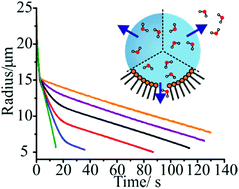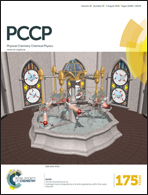The influence of the surface composition of mixed monolayer films on the evaporation coefficient of water
Abstract
We explore the dependence of the evaporation coefficient of water from aqueous droplets on the composition of a surface film, considering in particular the influence of monolayer mixed component films on the evaporative mass flux. Measurements with binary component films formed from long chain alcohols, specifically tridecanol (C13H27OH) and pentadecanol (C15H31OH), and tetradecanol (C14H29OH) and hexadecanol (C16H33OH), show that the evaporation coefficient is dependent on the mole fractions of the two components forming the monolayer film. Immediately at the point of film formation and commensurate reduction in droplet evaporation rate, the evaporation coefficient is equal to a mole fraction weighted average of the evaporation coefficients through the equivalent single component films. As a droplet continues to diminish in surface area with continued loss of water, the more-soluble, shorter alkyl chain component preferentially partitions into the droplet bulk with the evaporation coefficient tending towards that through a single component film formed simply from the less-soluble, longer chain alcohol. We also show that the addition of a long chain alcohol to an aqueous-sucrose droplet can facilitate control over the degree of dehydration achieved during evaporation. After undergoing rapid gas-phase diffusion limited water evaporation, binary aqueous-sucrose droplets show a continued slow evaporative flux that is limited by slow diffusional mass transport within the particle bulk due to the rapidly increasing particle viscosity and strong concentration gradients that are established. The addition of a long chain alcohol to the droplet is shown to slow the initial rate of water loss, leading to a droplet composition that remains more homogeneous for a longer period of time. When the sucrose concentration has achieved a sufficiently high value, and the diffusion constant of water has decreased accordingly so that bulk phase diffusion arrest occurs in the monolayer coated particle, the droplet is found to have lost a greater proportion of its initial water content. A greater degree of slowing in the evaporative flux can be achieved by increasing the chain length of the surface active alcohol, leading to a greater degree of dehydration.


 Please wait while we load your content...
Please wait while we load your content...